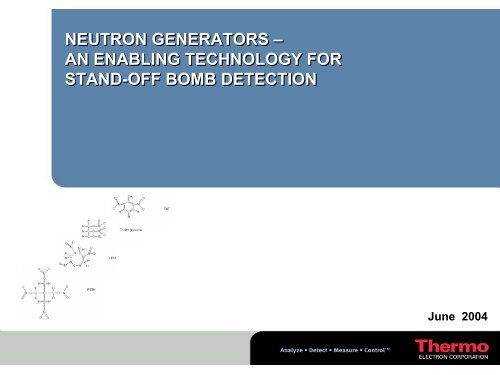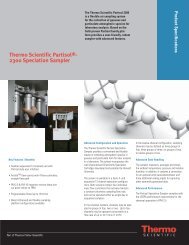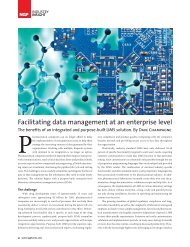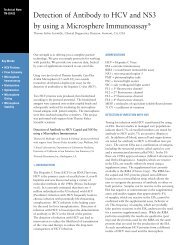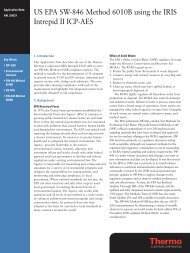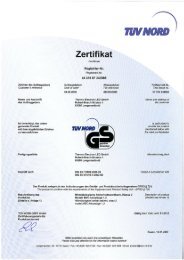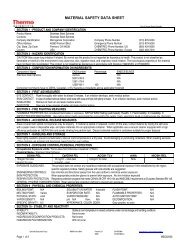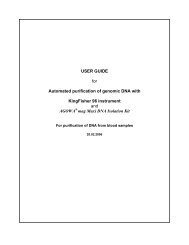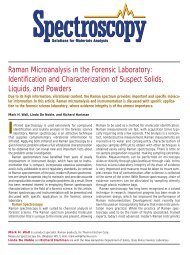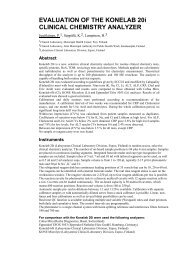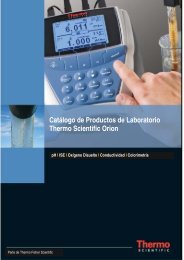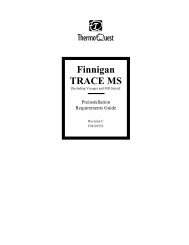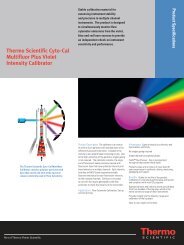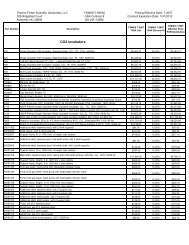Neutron Generator Background - Thermo Scientific Home Page
Neutron Generator Background - Thermo Scientific Home Page
Neutron Generator Background - Thermo Scientific Home Page
You also want an ePaper? Increase the reach of your titles
YUMPU automatically turns print PDFs into web optimized ePapers that Google loves.
NEUTRON GENERATORS –<br />
AN ENABLING TECHNOLOGY FOR<br />
STAND-OFF STAND STAND-OFF OFF BOMB DETECTION<br />
June 2004
Total Reaction Cross Section [barn]<br />
10<br />
1<br />
0.1<br />
0.01<br />
0.001<br />
<strong>Neutron</strong> <strong>Generator</strong> <strong>Background</strong><br />
Energy Dependence of 2 H(d,n) 3 He & 3 H(d,n) 4 He<br />
D-T<br />
D-D<br />
10 100 1000<br />
Deuteron Energy [keV]<br />
10000 100000<br />
• Small electrostatic particle accelerator<br />
• Hermetically sealed vacuum device<br />
• Hydrogen isotopes impinge metal hydride<br />
target<br />
• Nuclear fusion reactions:<br />
– D-D (En = 2.5 MeV)<br />
– D-T (En = 14.1 MeV)<br />
• Traditional high yield neutron generators use<br />
cold cathode ion sources<br />
• Tritium activity ranges from 2 – 10 Ci<br />
MP 320
Fission Cross Section [barns]<br />
1E+06<br />
1E+04<br />
1E+02<br />
1E+00<br />
1E-02<br />
1E-04<br />
1E-06<br />
What is Active <strong>Neutron</strong> Interrogation?<br />
Large Object <strong>Neutron</strong> Radiography<br />
Sensors Create 2-D Images<br />
(Image courtesy of B. Sowerby, Commonwealth <strong>Scientific</strong><br />
and Industrial Research Organisation, Australia )<br />
<strong>Neutron</strong>s Fission Special Nuclear Material<br />
Sensors Look For Fission Signatures<br />
ENDF/B-VI U-235 (N,F)<br />
ENDF/B-VI U-238 (N,F)<br />
1E-08<br />
14 MeV<br />
1E-10<br />
1.E-10 1.E-08 1.E-06 1.E-04 1.E-02 1.E+00 1.E+02<br />
<strong>Neutron</strong> Energy [MeV]<br />
i) Gamma-Rays From<br />
Fast <strong>Neutron</strong> Inelastic<br />
Scattering<br />
ii) Prompt <strong>Neutron</strong>s<br />
From Fast Fission<br />
Fast <strong>Neutron</strong><br />
Pulse From<br />
<strong>Neutron</strong><br />
<strong>Generator</strong><br />
i) Thermal <strong>Neutron</strong> Capture<br />
Gamma-Rays<br />
iii) Thermal <strong>Neutron</strong> Die-Away<br />
i) Gamma-Rays From the<br />
Decay of Activation<br />
Products<br />
ii) Prompt <strong>Neutron</strong>s From<br />
Thermal Fission ii) Delayed Fission <strong>Neutron</strong>s<br />
Thermal <strong>Neutron</strong>s Generated As Fast<br />
<strong>Neutron</strong>s Are Scatterd To Lower<br />
Energies At A Rate Dependent Upon The<br />
Surrounding Materials<br />
0 100 200 300 400 500 600 700 800 900 1000<br />
Time [microseconds]<br />
Signal Intensity [Counts]<br />
<strong>Neutron</strong>s Lead to Prompt Gamma Emission<br />
Sensors Examine Unique Elemental Signatures<br />
2000<br />
1500<br />
1000<br />
500<br />
0<br />
16<br />
Oxygen<br />
16<br />
O n,<br />
p<br />
( ) N<br />
0 1 2 3 4 5 6 7 8<br />
Photon Energy [MeV]<br />
<strong>Neutron</strong>s Can Be<br />
Vector Collimated<br />
Sensors Image<br />
Elemental Density<br />
(Images courtesy of J. Kocher, Dynamics Technology. Inc. and P.<br />
Hurley and J. Tinsley, DOE Special Technology Laboratory)
<strong>Neutron</strong> <strong>Generator</strong> Analytical Techniques<br />
nelastic Scattering<br />
– Low Z elements<br />
such as C, O, N<br />
– Chemical explosives<br />
detection<br />
n,2n) Multiplication<br />
– High Z elements<br />
such as Bi, Pb, U<br />
– Identify radiation<br />
shielding<br />
ast Fission<br />
– Elements U & Pu<br />
– Special nuclear<br />
materials detection<br />
eutron Slowing Down<br />
– Low Z elements<br />
– Can identify large,<br />
anomalous<br />
concentrations<br />
ransmission/<br />
ttenuation<br />
– Images with contrast<br />
sensitive to low Z<br />
material<br />
Fast <strong>Neutron</strong>s<br />
Inelastic Scattering, (n,2n)<br />
Multiplication, Fission<br />
(n,2n) Multiplication,<br />
Fission<br />
<strong>Neutron</strong> Slowing<br />
Down via Σ<br />
Transmission/<br />
Attenuation<br />
Transmission/<br />
Attenuation<br />
Inelastic Scattering<br />
Prompt Gamma<br />
Prompt <strong>Neutron</strong><br />
Delayed Gamma<br />
Delayed <strong>Neutron</strong><br />
<strong>Neutron</strong> Die-Away<br />
Radiography<br />
Tomography<br />
Associated Particle<br />
Absorption, Fission<br />
Fission<br />
Decay Following<br />
Absorption or Fission<br />
Decay Following<br />
Absorption or Fission<br />
Associated Particle Imaging:<br />
Slow <strong>Neutron</strong>s<br />
• Absorption<br />
– Most elements<br />
– Identify chemical<br />
explosives<br />
• Thermal Fission<br />
– Fissile isotopes of U<br />
and Pu<br />
• Decay<br />
– Medium Z elements<br />
– Helps identify<br />
structural & other<br />
materials<br />
Alpha pulses with<br />
P47 scintillator<br />
(T ½ < 50 ns)


